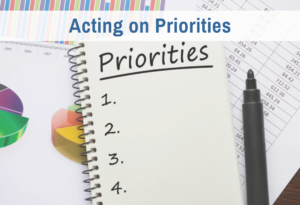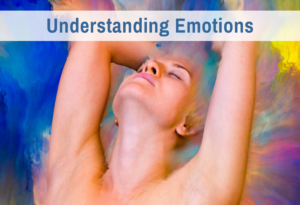In my last article, I argued that accepting reality helps you move from a state of suffering to a state of serenity. Indeed, when you are suffering, achieving serenity is a practical short-term goal. It provides an important stepping stone to a deep, lasting happiness. So let’s explore this important transitional state.
Serenity and the contemplative emotions
Serenity is a peaceful, restful state in which you do not feel impelled to act. Technically, you are not experiencing the “action impulses” that accompany such emotions as desire, anger, fear, aversion, pride, and confidence. You do feel some emotions, but only ones that are contemplative in nature, such as love, sadness, resignation, relief, and contentment. Let’s look at these more closely.
Love is the emotion you have when you evaluate something as good per se. This is distinguishable from desire. If you love something and need to take action to get it, you will feel desire, which motivates you to act. But if you already have gained a value, say, a loved one, you can feel love at will just by contemplating the value of that person to you. Indeed, during mourning, the emotion of love will well up inside you as you contemplate your lost loved one — if you focus on his/her value to you and how much you care(d) as opposed to the loss.
This is in contrast to despair, which you feel when you see yourself cut off from gaining your values. Despair causes internal conflict. That’s the opposite of restful. Despair motivates you to try to find some other way forward and/or to resist accepting the facts. However, once you accept the inevitable, despair dissolves into a gentle resignation and sadness, which is consistent with serenity. Once you accept that no action is possible, you have no impulse to act and you no longer feel conflict.
Relief is the emotion you experience when a threat has been removed, so no action is needed. This, too, is a restful state with no impulse to act. For example, imagine you had been afraid you’d bungle a performance. Prior to the performance, you were in a state of conflict and overload. If you perform acceptably, these feelings disappear. That is the experience of relief, and it can be palpable. It makes you want to just rest for a moment and catch your breath.
This is in contrast to an intense joy in success that spurs you to express yourself. Sometimes people “high five.” Sometimes they skip and dance around the room. Sometimes they call a friend to talk about it. Joy often includes an action impulse. It is the opposite of serene, except in its mildest versions, say, contentment. If the extent of your expression of joy is a smile of contentment, that is compatible with serenity.
As you see, serenity can involve many kinds of emotions, but only those that are contemplative, not those that are action-oriented. This makes serenity a somewhat passive state, suitable for resting before action. Hence, it makes it an appropriate transition between suffering and happiness.
Transitioning out of suffering
You need a transitional state because suffering involves a vicious cycle that is self-reinforcing.
Motivation doesn’t necessitate your next action; you can act in contradiction to any action impulse if you are aware of it in time. But motivation does determine your default action, meaning the action you will take if you are passive and don’t intervene, or if you drop your focus. If the default action pays off in some way, it will be reinforced and automatized.
Here’s a simple example to see how this works. Suppose you feel guilty about something you did: this feels bad. That automatically creates an aversion to thinking more about it. If that aversion is not challenged, it motivates you to avoid the issue. This gets you a short-term relief, which is reinforcing, so you will be even less inclined to examine guilt the next time.
Not thinking about a feeling of guilt is ultimately self-destructive. If the guilt is undeserved, not thinking about it is going to undermine your confidence. If you actually goofed, not thinking about how to remedy the situation is going to ceate additional problems. In either case, there will be more bad situations about which you may feel guilty. Since you reinforced the default action (avoid the issue), that will be highly motivated. You will need to exert more effort to stop yourself from running away when you decide to deal with it. If you don’t exert it this time, it will be even harder the next, and there will be even worse ramifications. This is how you can get sucked into a vicious cycle of suffering that feels like it is difficult to break out of.
Conflict and Compulsion
If you analyze motivation in terms of action impulses, there are two distinct cases that foster suffering.
In the first case, your action impulses contradict one another, causing internal conflict. For example, imagine waking up in the middle of the night worrying about an issue. On the one hand, you feel an urge to get up and do something about it. On the other, you are tired and you want to roll over and go back to sleep. If you get up, you kill the possibility of getting back to sleep, and probably can’t solve the problem in your exhausted state. If you stay in bed, you are unlikely to be able to fall asleep with this issue on your mind, nor solve it. In such a case, it can seem that you are damned if you do, damned if you don’t. There is no way out. This type of internal conflict is a large component of suffering.
In the second case, both value-oriented and threat-oriented emotions point you in the same direction. In such a case, you will feel driven to act. A simple example: suppose you don’t want to do a hard task and you do want to stop and have a snack.The desire for the snack is amplified by the aversion to the work, so (barring an intervention) you wind up at the fridge. If this happens once, it’s not a problem. But if it is repeated, you strengthen the resistance to the task and automatize a full-blown compulsion to eat.
A compulsion, once formed, acts like blinders. The motivation is strong enough that it takes extra self-awareness to intervene to determine whether eating that snack is actually in your rational self-interest. Notice that this is true whether the compulsive action started out rational or not. Many high performers develop a compulsion to work. If it’s not challenged, they lose sight of the damage to their health of overwork. I think it’s fair to say that all self-destructive behavior involves compulsions. And, of course, self-destructive behavior is the recipe for suffering.
To break out of any of these vicious cycles, you need to do two things: 1) Intervene so you don’t act on the impulses. 2) Activate a value-oriented context that enables you to find a positive way forward.
This is what accepting reality achieves. In the previous article, I explained that accepting reality entails switching to an intellectual purpose. Your goal becomes: Understand what the facts are and introspect your emotions about them. This is the process that results in a sense of serenity. In essence, it gives you an alternate purpose. Instead of trying to solve an intractable problem or fight against resistance, just get clear on the facts and their meaning to you. This process gets you clearer on your values, which in turn lets you see new possibilities for action. That’s what helps you break out of a vicious cycle.
Transitioning out of serenity into happiness
To continue the sleep example, I no longer lie awake in bed in the kind of conflict I described. As soon as I notice I am awake in this state, I accept the fact that my sleep is already compromised. I will need to sleep late or take a nap the next day or I function with less than my usual acuity. In other words, I accept reality.
The serenity that comes from that acceptance enables me to examine my options freely to choose the best one. Sometimes I move to the floor to do restful breathing exercises and eventually get back to sleep after a delay. Sometimes I get up, don yellow glasses, and work on the problem for a while. But always I do something that I see is in my rational self-interest, given that a perfect night’s sleep is no longer possible. And I always feel a bit of contentment that I have made the best of a difficult situation.
What I’ve described is the start of a virtuous cycle of value-oriented action, in place of a vicious cycle of conflict. The intermediate state of serenity is essential to the transition.
The emotional quiet of serenity gives you the mental space needed to think. You cannot consider the way forward if your attention is pulled off by conflict or compulsion. But once your mind is quiet, you can choose to examine your options to find the best way forward. When you see it, you will feel a desire to act and there will be very little inertia to overcome. In other words, initiating thinking and action takes only a small, doable effort when you are in a quiescent state of serenity, even when you are very tired in the middle of the night.
The benefit of serenity
This is why serenity is such an important transitional state to keep in mind. Adding this transitional state makes it easier to break out of a vicious cycle of suffering and easier to initiate a virtuous cycle of goal-directed action.
Serenity is self-evidently better than continuing suffering. Once you understand that accepting reality can bring you to serenity, you can use that information to motivate yourself to deal with the conflict and compulsions inherent in suffering. That is a doable step.
Once you are in a state of serenity, you can quietly survey the situation looking for an opportunity to gain a value. Once you see that opportunity, it motivates you to exert some effort.
None of this is zero effort. None of this is automatic. But the key to managing one’s own motivation is to exert effort where it has the biggest payoff. And aiming for serenity, and resting there a bit to survey your values, is a great way to adjust course.
For completeness, I’ll just remind you that serenity is not the goal. Happiness is the goal. A large amount of serenity is compatible with happiness, but 100% serenity is not. To experience enduring happiness, you need success in the world. The more meaningful that success, the deeper the happiness.









Dear Jean,
This blog is right on and I want to share my thoughts with you as they are even clearer now. Aging, I am 86, was defeating me: I felt like I had accomplished so little, time was running out, I could no longer play the piano which is my livelihood, I now have to rely on my son to drive me places and to pay most of the mortgage, maintain the house, etc. Then I read Harry’s recommendation of “Lifespan, Why we age and why we don’t have to”. After reading it I started taking Nad as I was convinced I had nothing to lose at this stage. Immediately my attitude changed to one of hopefulness. Then I read Ulysses poem, sent in Diane Durante’s blog, and listened to Peikoff’s lecture that included the lines from the poem “Tho’ much is taken, much abides;…”. In the meantime I was inspired by Lisa van Damme’s Cyrano de Bergerac lecture and started working on excerpts from that great work for my few remaining students to perform. Talk about motivtion! I would get very little sleep if I couldn’t experience serenity at bedtime and throughout the night. Thanks so much for your clarifying thoughts on serenity.
I’m so glad you found this helpful, and gladder that you have found a way to pursue values despite the major change in your life.